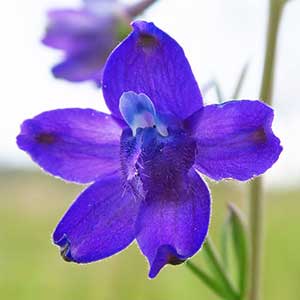Delphinium nuttallii subsp. nuttallii
(synonym of Delphinium oreganum)
Delphinium bakeri
Willamette Valley larkspur
Baker's delphinium, Baker's larkspur
40-70 cm.
(45-)60-85(-100) cm;
base reddish, glabrous.
blade pentagonal to round, 1-6 × 1.5-8 cm, margins crenate, glabrous; ultimate lobes 3-5, width 2-5 mm (basal), 5-30 mm (cauline), widest at middle or in proximal 1/2.
8-23-flowered, at least 2 times longer than wide;
pedicel 1-6(-9) cm, glandular-puberulent;
bracteoles 4-6 mm from flowers, green to blue, lance-linear, 5-8(-13) mm, glabrous to glandular-puberulent.
sepals blue or bluish purple, spurs 10-13 mm;
lower petal blades 4.5-6.5 mm.
sepals dark bluish purple, nearly glabrous, lateral sepals spreading, 9-11 × 4-5 mm, spur apex decurved, ± horizontal, 9-13 mm;
lower petal blades ± covering stamens, 5-7 mm, clefts 2-3 mm;
hairs sparse, mostly near base of cleft, centered or on inner lobes, white.
18-20 mm, 3.5-4 times longer than wide, glabrous.
unwinged;
seed coats smooth.
= 16.
Delphinium nuttallii subsp. nuttallii
Delphinium bakeri
Of conservation concern.
Delphinium bakeri is possibly extinct in the wild because of cultivation and sheep grazing in the small area where it grows. It is known from only two localities and has not been collected since 1960. Plants have been grown at Strybing Arboretum, Golden Gate Park, San Francisco. Although their geographic ranges are distinct, D. bakeri is most similar to, and probably closely related to, D. trolliifolium. The former has more rounded incisions on the leaves than the latter, and the pedicel of D. bakeri are consistently glandular. Glandular pedicel appear only occasionally in D. trolliifolium.
(Discussion copyrighted by Flora of North America; reprinted with permission.)


